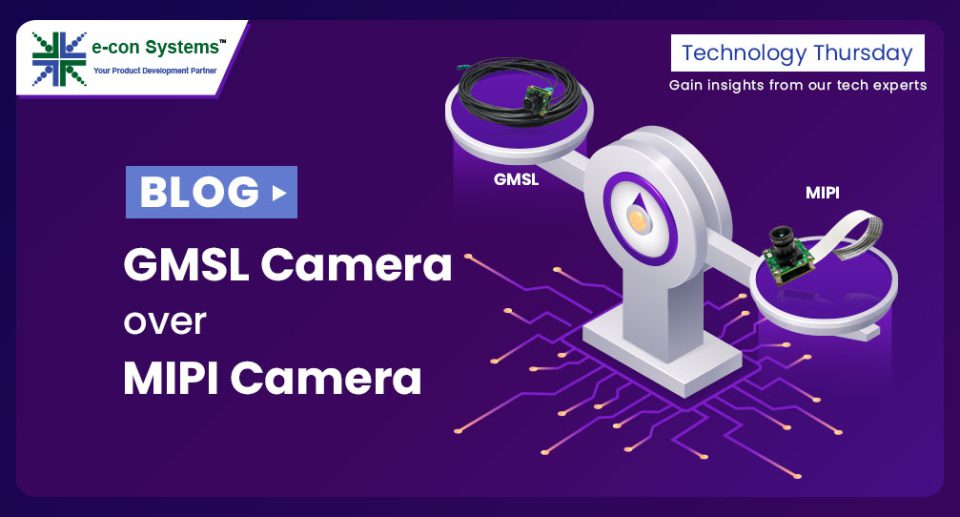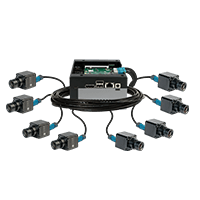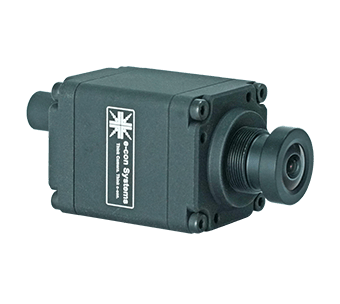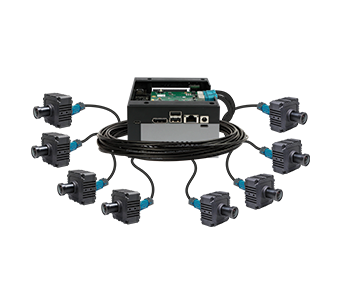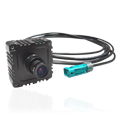High bandwidth, long range support, data integrity, better performance, and reliability of the camera will continue to be key requirements for embedded vision applications across various industries such as automotive, robotics, smart city, etc. Some of the most popular camera interfaces used in such applications are MIPI CSI-2, USB 3.0, and GigE. However, they are not capable of serving the growing needs of many new age applications. Other interfaces like Ethernet and CAN are fairly common in many cars and automotive applications. But they aren’t fast enough to transmit large amounts of high-resolution digital video data.
This is where the Serializer/Deserializer (SerDes) technique becomes a game changer.
The SerDes technique is very popular across telecom, datacom, industrial, and cable interconnect applications as it offers high data rates, long distance support, and better performance. This serial link technology also performs reliably in the harsh industrial and outside environments to deliver data fast with low latency. The primary use of a SerDes technique is to provide data transmission over a single coaxial cable or differential pair cables (STP, SPP, etc.) to minimize the number of Input/Output pins and interconnects.
Gigabit Multimedia Serial Link™ (GMSL) cameras use the GMSL and GMSL2 technology – a SerDes technique – to carry high speed video, bidirectional control data, and power over a single coaxial cable.
This article looks at how the GMSL interface compares with one of the most popular camera interfaces called MIPI.
What is a GMSL interface?
Before we start looking at the differences between GMSL and MIPI interfaces, let us first try to understand what a GMSL interface is.
GMSL is a high-speed serial interface primarily used in automotive video applications such as infotainment and advanced driver assistance systems (ADAS). It is also used in many smart traffic and robotic applications. The GMSL interface comprises families of serializer and deserializer with different interfaces like HDMI, CSI-2, DSI, asymmetric DSI, eDP, oLDI, and single/dual/quad GMSL1/GMSL2 at the input or output. GMSL uses a serializer on the transmitter side for converting data to a serial stream, and a deserializer on the receiving side for converting serial to a parallel word for processing. It can transfer video at a speed of up to 6 Gb per second.
Below is the block diagram of an embedded vision system that uses the GMSL interface.

What is a MIPI interface?
Before we get into the benefits of using GMSL camera and its applications, let us learn what a MIPI camera is.
MIPI is a high speed protocol which transmits video and image data between a camera and the host processor. They are widely used in mobile devices. MIPI CSI-2 – one of the MIPI interface variants – offers a maximum bandwidth of 6 Gb per second, with an attainable bandwidth of roughly 5 Gb per second. MIPI CSI-2 connects an image sensor with an embedded board to control and process the image data. This helps the sensor and embedded board to act together as a camera system to capture images. The maximum cable length for a standard MIPI CSI-2 camera connection is 30 cm.
To learn more about MIPI cameras, please visit What is a MIPI camera? How does MIPI camera work?
Now let us look at the benefits of using GMSL camera interfaces and its performance.
GMSL Camera vs MIPI Camera
GMSL camera interface meets the growing demand of fast data rates, high bandwidth, data integrity and better EMI/EMC performances. We will look at the similarities and differences between GMSL and MIPI interfaces along the following parameters:
- Distance of transmission
- EMI/EMC performance
- Video duplication
- Automatic Repeat Request (ARQ) feature
- Backward compatibility
- Virtual channel support
- Compatible platforms
Distance of transmission
Let us consider a large size vehicle like truck where the distances between the computing unit and each camera module is larger than 30 cm. That is where the GMSL SerDes technology can be more helpful enabling a long distance transmission up to a distance of 15m. These cameras can be placed 15 meters away from the host processor through the 50Ω coaxial cable or 100Ω STP to operate at full speed, and still support a high frame rate and less latency.
Also, higher cable attenuation at higher frequencies can be compensated by using an adaptive line equalizer in GMSL. This cable equalizer has 12 levels of compensation to handle up to 30m coax and 15m STP cable lengths. At the other end, the maximum cable lengths for a standard MIPI® CSI-2 camera connection is 30 cm.
EMI/EMC Performance
Electromagnetic interference (EMI) remains a serious challenge in cameras because this harmful interference affects the performance of the cable, connector, PCB combination and the electronic devices located in the vicinity. To ensure that electronic devices will perform as designed, they must be protected from EMI. Thus EMC/EMI testing is performed to ensure they do not cause harmful interference.
The programmable output – spread spectrum capability – is built into each of the GMSL’s serializer and deserializer ICs to enhance safety based camera applications. It improves the electromagnetic interference (EMI) performance of the link without requiring an external spread-spectrum clock. MAX96705 is a compact serializer with high immunity mode (HIM), which provides more reliable reverse channel communication. This high-immunity mode in GMSL serializer is designed for robust control channel electromagnetic compatibility (EMC) tolerance.
Video duplication
The GMSL Splitter mode is targeted for display applications. This mode is defined as a single serializer connected to two deserializers. In the splitter mode, it is possible to mask the output of each video pipe to each GMSL PHY. This is called video duplication.
The aggregation mode is also known as reverse splitter mode, which targets camera applications. It is defined as two serializers connected to a single deserializer.
Automatic Repeat Request (ARQ)
ARQ is an error control and packet recovery method employed in GMSL to ensure reliable data transmission. This method allows the transmitting side to automatically re-transmit packets when it doesn’t acknowledge the packet from the receiver to stay error-free. In GMSL2, ARQ works in combination with cyclic redundancy check (CRC) to detect whether the packets are received or not. This allows high robustness of critical control functions in the system.
Backward compatibility
GMSL1 and GMSL2 interfaces support the backward compatibility mode. This GMSL1 backward compatibility mode allows the GMSL2 SerDes components to operate with the previous generation GMSL1. The GMSL2 backward compatibility mode can be operated similarly. However, there are some operational differences between GMSL1 and GMSL2 modes. Also, some GMSL2 features may not be available when operated in GMSL1 mode.
Given below is a pictorial representation of how GMSL2 and GMSL1 interfaces work together:

The data transmission between the SER and DES starts when the valid clock is detected and high speed PLL locks. The input 3Gbps or 1.5Gbps video is limited by the GMSL1 DES.
Virtual channel Support
Using virtual channels, the SerDes architecture enables multiple camera capture. Virtual channels are supported by the MIPI CSI-2 and CSI-3 specifications. For dual 4-lane MIPI CSI-2, a GMSL deserializer (like MAX9296), can effectively decode up to 16 virtual channel IDs. This deserializer combines all incoming video streams and provides the output through CSI-2 (using virtual channel identified packets). The frame sync locked status has to be achieved here.
Have a look at the below image to understand how a multicamera system would use the GMSL interface for transmitting image or video data to the host processor:
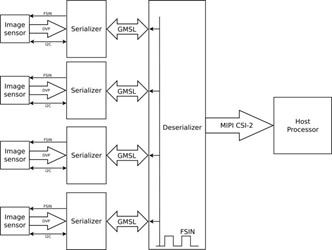
Compatible platforms
GMSL Cameras have off-the-shelf support for NVIDIA® Jetson™ development kit and Connect Tech’s Rogue, Rudi-AGX and Rudi NX platforms based on Jetson Xavier™ NX. This enables rapid prototyping and faster deployment of vision-enabled products. The UART interface, compatible with all GMSL devices, sends commands from device to device through several UART packets. At the other end, MIPI® CSI interfaces are also widely supported by a range of different developer kits such as Jetson™ Nano, TX2, AGX Xavier and so on.
Cost
GMSL cameras with longer cables offer the highest performance but are not required in typical or short-distance applications. Since a GMSL camera is used for longer cable runs and has to be high performing, it is costlier than a MIPI or USB camera. But using coax cables instead of STP cables for SerDes links has cost advantages. Coax cables are cheaper, lighter, more flexible, and less lossy at high frequencies. In MIPI, with the introduction of C-PHY℠, the system cost has been reduced. But in some cases, if a driver for the MIPI camera is not available, extra development costs can be incurred.
Apart from MIPI and GMSL, USB is also one of the most popular camera interfaces. If you wish to learn how MIPI camera compares to a USB camera, have a look at MIPI camera vs USB camera – a detailed comparison.
To learn how to choose an interface for your embedded vision system, visit How to choose the right interface for an embedded vision system.
Embedded vision applications where GMSL is typically preferred over other interfaces
As already discussed before, interfaces like MIPI or USB will not be sufficient in applications that require large amounts of image or video data to be transmitted over long distances. In this section, we will look at some of the most common camera based applications where a GMSL interface is preferred over others.
Robotics
Autonomous mobile robots (AMR) are used for various automated tasks in warehousing, automotive manufacturing, logistics, e-commerce, healthcare, etc. Cameras in AMR and robotics systems serve multiple imaging needs. In AMR, the cameras are required for navigation, object detection, and object identification. Fast frame rates and low exposure time are key factors to be considered for selecting a camera for robotic applications. GMSL cameras provide the optimal solution since it has fast frame rates and low exposure time capabilities. Also as already discussed, it can transmit data up to a distance of 15m from host for remote robotics.
Smart Traffic Systems
Smart Traffic system helps in improving traffic management and enhances safety by using sensors, cameras, routers and other technologies. This application demands long distance transmission of the captured image and video data. Thus, the GMSL interface with 15 m cable and multiple camera capture capability is used for transmitting data to the host platform reliably.
Advanced driver assistance systems (ADAS)
ADAS systems are helping to make roadways safer. They also enhance driving experience with functions such as lane positioning, parking assistance and collision avoidance. With the advantages discussed in this article, the GMSL SerDes technology meets the essential needs of an ADAS system such as high reliability and flexibility for uncompressed camera feed transmission.
Fleet management
In a fleet management system, multiple cameras are required to cover large size vehicles such as trucks and forklifts. Recurring accidents owing to blind spots is one of the biggest challenges in such vehicles. A typical solution to this problem is using a surround view system which offers 360° awareness for the driver by eliminating blind spots. A surround view system involves a multi camera system where the cameras are placed at a large distance from the host processor. This demands the usage of an interface like GMSL which can reliably transmit data over a large distance.
Automotive infotainment systems
Automotive infotainment systems provide an immersive experience for drivers and passengers with features such as passenger entertainment, display of vehicle and environmental information, navigation and connectivity. Such systems often require a camera to be placed at a considerable distance from the host processor (as in the case of a surround view system). Hence, GMSL is preferred over a MIPI or USB.
The application of GMSL cameras are not limited to the above, but can also be used in inspection cameras, street lighting cameras.
e-con’s GMSL/GMSL2 Camera
e-con systems offers a wide range of GMSL/GMSL2 cameras for various applications. They come with features such as HDR, IP66/67 rated enclosures, global shutter as well as rolling shutter, and LED flicker mitigation. They are also compatible with the NVIDIA Jetson development kit. Following is the comprehensive list of e-con’s GMSL cameras,

Prabu is the Chief Technology Officer and Head of Camera Products at e-con Systems, and comes with a rich experience of more than 15 years in the embedded vision space. He brings to the table a deep knowledge in USB cameras, embedded vision cameras, vision algorithms and FPGAs. He has built 50+ camera solutions spanning various domains such as medical, industrial, agriculture, retail, biometrics, and more. He also comes with expertise in device driver development and BSP development. Currently, Prabu’s focus is to build smart camera solutions that power new age AI based applications.




